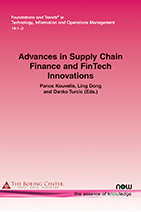Guarantor Financing Selection Under Influence of Supply Chain Leadership and Economies of Scale
By Tiantian Lin, Zhejiang University, China, tiantlin@zju.edu.cn | Weihua Zhou, Zhejiang University, China, larryzhou@zju.edu.cn | Gangshu (George) Cai, Santa Clara University, USA, gcai@scu.edu
Abstract
This paper investigates manufacturer guarantor financing (MG) and third-party logistics (3PL) guarantor financing (LG) in a four-party supply chain game that features a manufacturer, a 3PL, a capital-constrained retailer, and a bank. The manufacturer or 3PL can act as the guarantor for the retailer who borrows bank credit. Two different leadership structures are investigated, namely, Nash game and manufacturer leadership Stackelberg game, where the manufacturer and 3PL make their decisions simultaneously and sequentially, respectively. Our analysis shows that the supply chain under both leadership structures prefers guarantor financing to traditional bank financing when the supply chain is cost-efficient. Nevertheless, both upstream firms prefer the other to be the guarantor in the Nash game, whereas under the manufacturer Stackelberg leadership, the 3PL may prefer itself to be the guarantor. Furthermore, the supply chain under guarantor financing with a longer decision hierarchy (i.e., the Stackelberg game) can be conditionally more efficient than that with a shorter one (i.e., the Nash game). These findings enhance our understanding of the value of guarantor financing in a capital-constrained supply chain and the impact of leadership structure on financing decisions.
Emerging Advances in Supply Chain Finance and FinTech Innovations
Advances in Supply Chain Finance and FinTech Innovations examines three themes:
Financing Issues in Supply Chains look into popular working capital management financing practices: trade credits and guarantor practices including advanced trade credit practices in supply chains, guarantor financing practices for capital constrained retailers, and innovative practices of joint financing of capital constrained firms by a bank.
FinTech Innovations for Supply Chains examines business model innovations for supply chain financing supported through new platform technologies (such as blockchain), and simple financial technologies effectively implemented for high impact in supply chain risk management.
Advances in Risk Management of Operational Systems provide state-of-the art thinking on many risk issues in supply chain operations including disruption strategies over the product life cycle, the production planning complexities for a capital constrained manufacturer that uses Inventory Based Financing (IBF) scheme to fund its working capital needs, capacity procurement decision, capacity planning in the presence of demand and price uncertainty, and valuing complex real options in dynamic operational settings.

Companion
Foundations and Trends® in Technology, Information and Operations Management, Volume 14, Issue 1-2 Special Issue: Advances in Supply Chain Finance and FinTech Innovations
See the other articles that are also part of this special issue.